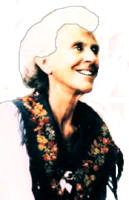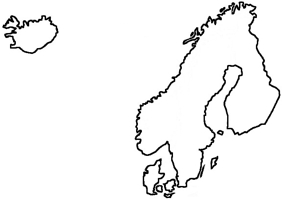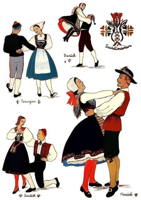
|
The Society of Folk Dance Historians (SFDH)
Folk Dances from Scandinavia
[
Home |
About |
Encyclopedia | CLICK AN IMAGE TO ENLARGE |

|
That side of the room where the spectators are.
LINE FORMATIONS
Two parallel lines at right angles to the Presence. The line on the left, counting from the Presence, is called "The Women's Side," the line on the right is called "The Men's Side."
QUADRILLE
A set of four or eight (double quadrille) couples in square formation.
In Danish dances, the first couple stands with their backs to the Presence, the second couple facing them, the third couple to the right, and the fourth couple to the left.
In Swedish dances, the couples on the left and right, counting from the Presence, dance first and are called "Premiär," the couples with their backs to the Presence and those facing the Presence are called "Second." The line on the left and the line nearest the Presence are called "The Women's Side." The line on the right and the line farthest away from the Presence are called "The Men's Side."
POSITION OF HAND
- In Danish dances, unless otherwise stated, the position of the hand is optional.
- In Swedish dances, unless otherwise stated, the hand is placed on the hips.
GRIPS
- Ordinary Grip or Waltz Grip (Danish and Swedish). The man puts his right arm around the woman's waist and grasps her right hand with his left, keeping it at shoulder height. The woman places her left hand on the man's right shoulder from behind.
- Waist Grip (Danish and Swedish).
- In couples, the man grasps the woman's waist and the woman places her hands on the man's shoulders.
- In a circle, the man puts his arms around the woman's waist, and the woman places her hands on the shoulders of the man, on either side of her.
- Cross Grip (Danish and Swedish). Partners cross hands in front, taking partner's right hand in own right, left hand in own left, either facing each other or with their sides toward each other.
- Thumb Grip (Swedish). The dancers grasp each other's right or left thumb with the elbows strongly bent and pointing downwards, and with their shoulders in a straight line.
- Dal Step (Swedish). Danced in 3/4 time. On the first beat the right foot is put down; on the second beat the right knee is slightly bent; on the third beat the heel is raised and a slight hop is taken on the right foot. Meanwhile, the left leg, with the ankle an knee stretched, is swung across the right leg and lifted about a foot-length from the floor.
- Östgöta Step (Swedish). Danced in 3/4 time. Consists of a change of step beginning with the left foot (left, right, left) and a running step with the right foot (right). The left foot always begins the step.
- Pas de Basque (Danish and Swedish). Steps begin alternately on the right and the left feet as follows: The right foot is put down to the fight and slightly forward; the left foot is moved in front of the right foot while the weight is transferred to it; then the right foot is lofted and put down close behind the left while the weight is changed back on to the right foot. The repeat is to the left.
- Polka-Mazurka Step (Swedish). This step resembles a change of step but on the first beat a small jump is taken and both feet are placed on the floor with one foot in front of the other. The rear foot should touch the floor a trifle earlier than the front foot.
- Bleking Step. With a jump both feet are put on the floor simultaneously, the left in front of the right foot. With another jump, the feet change places, et cetera, in rhythm with the music. Forward leg is straight and weight fo the body is chiefly on the other one which is slightly bent.
- Heel-Step with Bo-Peep. Danced in 3/4 time. This step is always done in couples, one partner behind the other one. A, the hindmost, with hands on the hips of the partner in front, B. B turns slightly to the right, leans somewhat to the left, and puts his right foot about a foot's length forward, and bends his left knee a little (this is done on the first part of the beat). During the second part of the beat, this position is kept and on the third part of the beat, the original position is resumed. A does the same as B, but does not lean to the left. The same movements but opposite. NOTE: During the first and second parts of the beat, the partners look into each other's eyes.
- Jumping-Step with Outflung Arms. Danced in 3/4 time. During the first part of the beat, both feet are put on the floor simultaneously, with bent knees a foot-length from each other, toes pointing outward, while arms are flung out widely, slightly bent at the elbows and fists clenched at shoulder level. On the second part of the beat, this position is kept, and on the third part the original position is resumed.
DOCUMENTS
- Choreogeography: Scandinavia, an article.
- Scandinavia, a country.
- Scandinavian Dances, a book.
- Scandinavian Impressions, an article.
Reprinted from the 1953 College of the Pacific (Stockton) Folk Dance Camp syllabus.
This page © 2018 by Ron Houston.
Please do not copy any part of this page without including this copyright notice.
Please do not copy small portions out of context.
Please do not copy large portions without permission from Ron Houston.

